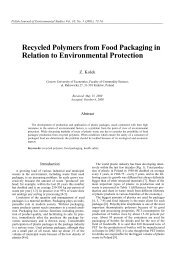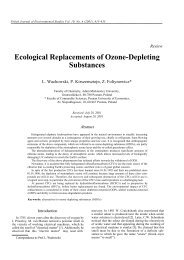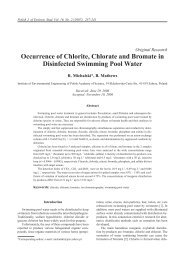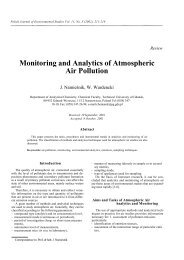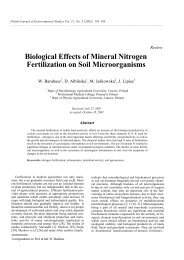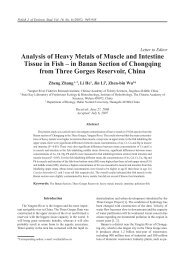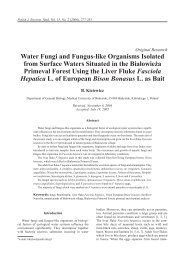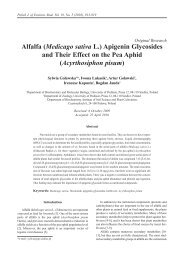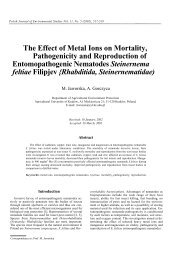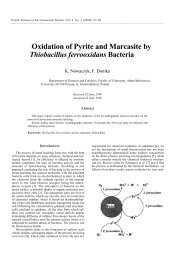Application of Ultrafiltration and Reverse Osmosis - Polish Journal of ...
Application of Ultrafiltration and Reverse Osmosis - Polish Journal of ...
Application of Ultrafiltration and Reverse Osmosis - Polish Journal of ...
You also want an ePaper? Increase the reach of your titles
YUMPU automatically turns print PDFs into web optimized ePapers that Google loves.
270<br />
Material <strong>and</strong> Methods<br />
Apparatus<br />
<strong>Ultrafiltration</strong> was carried out applying a SEPA CF-<br />
HP pressure apparatus equipped with a plate-frame module<br />
produced by Osmonics, membrane active area - 155<br />
cm 2 . The system operated in the cross-flow mode.<br />
<strong>Reverse</strong> osmosis was conducted in a GH 100-400 highpressure<br />
apparatus, capacity – 400 cm 3 , produced by the<br />
same company. The system operated in the dead-end mode<br />
on flat membranes whose active area was 36.3 cm 2 .<br />
Materials<br />
The wastewater was sampled from the Meat-Processing<br />
Plant “UNILAG” in Wrzosowa (southern<br />
Pol<strong>and</strong>) whose activity covers the slaughter <strong>and</strong> processing<br />
<strong>of</strong> pigs. It was characterized by considerable<br />
pollutant load, substantial amounts <strong>of</strong> suspended matter<br />
<strong>and</strong> high concentrations <strong>of</strong> total nitrogen <strong>and</strong> phosphorus.<br />
The values <strong>of</strong> the basic <strong>and</strong> eutrophic pollution<br />
indexes ranged widely during the whole production<br />
cycle. The characteristics <strong>of</strong> the wastewater are presented<br />
in Table 1.<br />
Coagulant<br />
Our research employed the technical coagulant PIX-<br />
113 (Fe og<br />
- 12.8%, Fe 2+ - 0.7%, H 2<br />
SO 4<br />
- 1%) which was<br />
added to the wastewater in the form <strong>of</strong> 1% wt. aqueous<br />
solution. The basic reagent dosage <strong>of</strong> 6.5 g coagulant / g<br />
phosphorus in the wastewater was calculated on the basis<br />
<strong>of</strong> a chemical reaction <strong>of</strong> phosphates. The process <strong>of</strong> coagulation<br />
with the basic dosage <strong>of</strong> the coagulant as well as<br />
its 100% <strong>and</strong> 200% excess was carried out at 18 0 C - 20 0 C,<br />
pH <strong>of</strong> the wastewater being 6.4-7.6. The fast stirring time<br />
was 45 s, while the time <strong>of</strong> slow stirring <strong>and</strong> sedimentation<br />
was 30 min each. The degree <strong>of</strong> the wastewater purification<br />
was assessed on the basis <strong>of</strong> a decrease in COD<br />
<strong>and</strong> phosphorus concentration.<br />
Membranes<br />
Bohdziewicz J. et al.<br />
The membranes used in the pressure-driven membrane<br />
operations are as follows: flat polysulfone ultrafiltration<br />
membranes SEPA-H designated by HN <strong>and</strong> HZ,<br />
DS-CQ cellulose membrane, two DS-GH 2K <strong>and</strong> DS-GH<br />
8K composite membranes, <strong>and</strong> one SS-10 membrane for<br />
reverse osmosis made <strong>of</strong> cellulose acetate. Table 2 shows<br />
the operating conditions <strong>and</strong> separation characteristics<br />
recommended by the manufacturer <strong>of</strong> the membranes.<br />
Methods <strong>and</strong> Analysis<br />
In the first system which combined ultrafiltration<br />
with reverse osmosis the raw wastewater pre-treated<br />
in a fat separator, floatation machine <strong>and</strong> subsequently<br />
filtered through a 0.2 mm - 0.4 mm s<strong>and</strong> filter was<br />
subjected to ultrafiltration treatment which aimed at<br />
removing suspended <strong>and</strong> macromolecular matter. The<br />
processes, which used the HN, HZ, DS-GH 2K <strong>and</strong><br />
DS-GH 8K membranes, were carried out at the transmembrane<br />
pressures recommended by the manufacturer,<br />
while in the case <strong>of</strong> the DS-CQ membrane it was<br />
0.3 MPa. The linear flow velocity <strong>of</strong> the filtered medium<br />
over the membrane surface was 2m/s each time.<br />
The next stage was reverse osmosis. The operating parameters<br />
<strong>of</strong> the process were: transmembrane pressure<br />
- 2.0 MPa, stirring rate - 200 rpm. The effectiveness <strong>of</strong><br />
both processes was assessed based on the removal degree<br />
<strong>of</strong> the contaminants from the wastewater <strong>and</strong> the<br />
values <strong>of</strong> permeate fluxes.<br />
In the other system, ultrafiltration was replaced with<br />
coagulation followed by reverse osmosis carried out at the<br />
transmembrane pressure <strong>of</strong> 2.0 MPa <strong>and</strong> stirring rate <strong>of</strong><br />
200 rpm. The transport characteristics <strong>of</strong> the membranes<br />
were determined describing the dependence <strong>of</strong> the volume<br />
deionized water flux on the transmembrane pressure<br />
applied.<br />
The concentrations <strong>of</strong> total nitrogen, phosphorus <strong>and</strong><br />
COD were determined by means <strong>of</strong> the tests which used<br />
Table 1. Pollution concentration in raw wastewater.<br />
Pollution indices<br />
Concentration <strong>of</strong> pollution in raw wastewater<br />
[mg/dm 3 ]<br />
Load pollution<br />
[kg/d]<br />
Range Mean value Mean value<br />
Permissible<br />
st<strong>and</strong>ards [mg/dm 3 ]<br />
COD 2780 – 6720 4584 309.2 150<br />
BOD 5<br />
1200 – 3000 19721 126.8 30<br />
Total nitrogen 49 – 287 198 13 30<br />
Total phosphate 15 – 70 32 2.1 5*<br />
Total suspension 112 – 1743 396 26.1 50<br />
Detergents 7 – 21 11.3 0.75 5<br />
*For a wastewater treatment plant whose daily flow is below 2000 m 3 .



